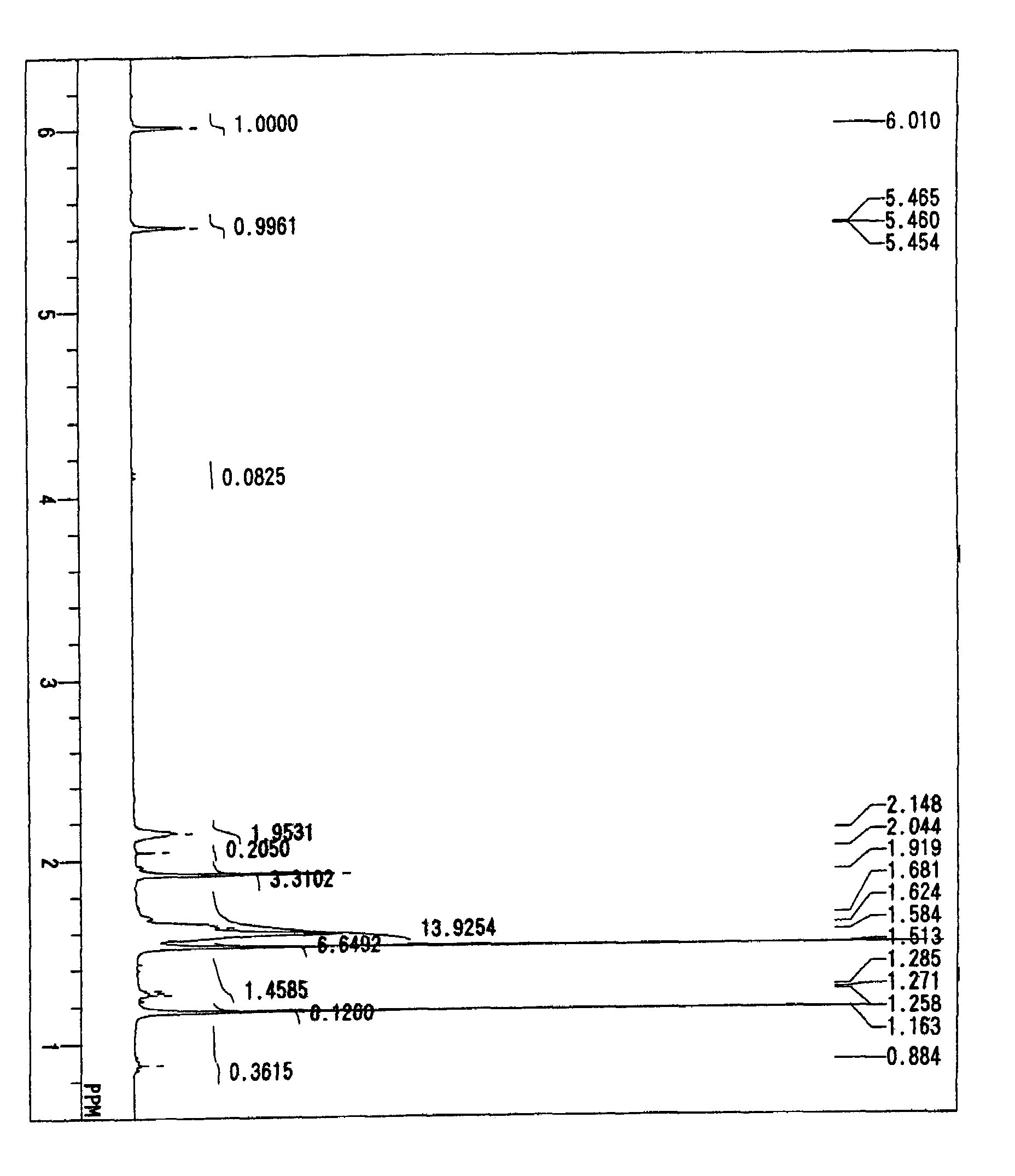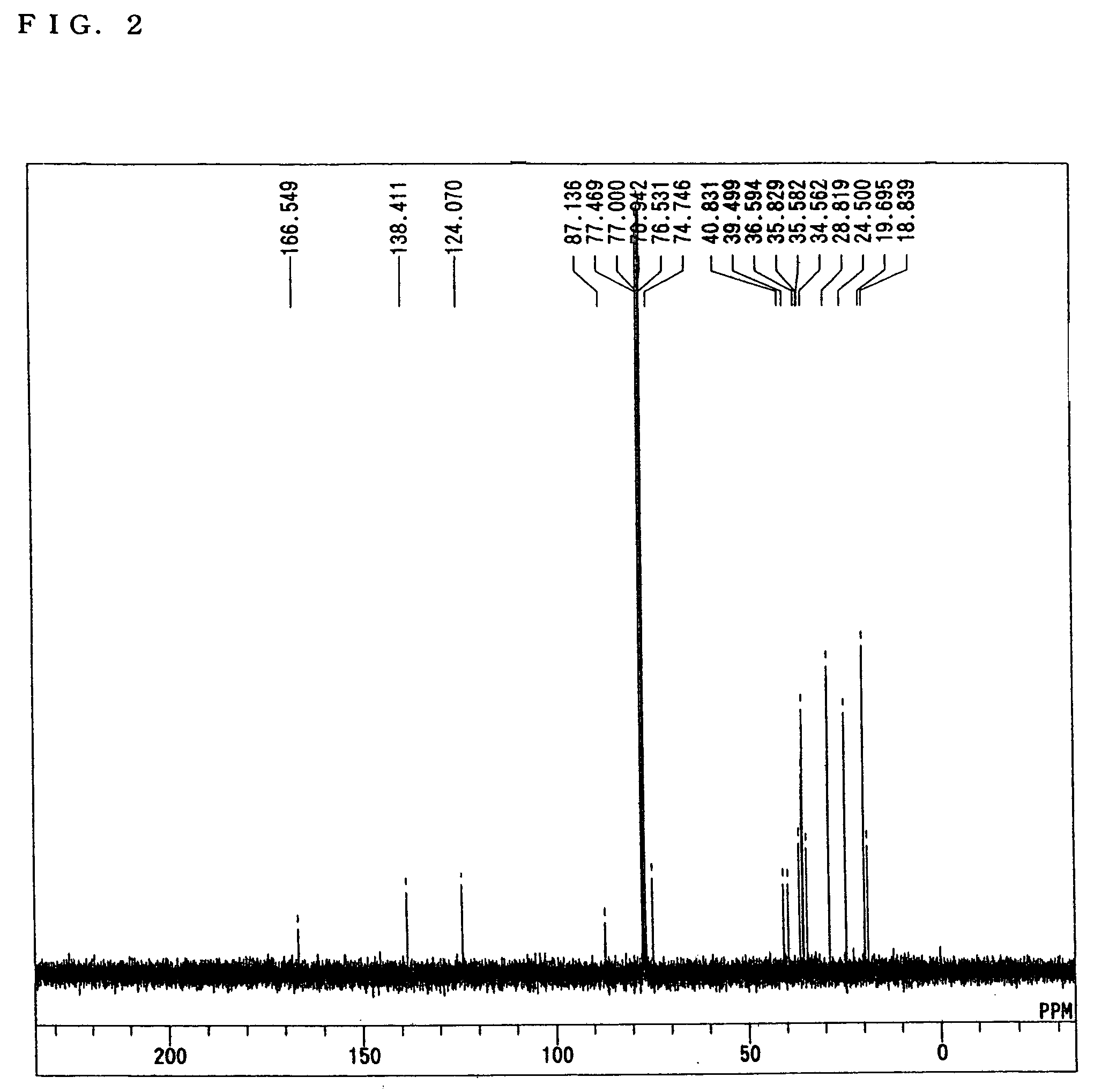Adamantane derivatives and resin compositions using the same as raw material
a technology of adamantane derivatives and resin compositions, applied in the field of adamantane derivatives, can solve the problems of inability to meet the above properties such as etching resistance, difficult to allow compositions to have a good uniformity, and achieve excellent adhesion to the substrate, excellent etching resistance, and high accuracy
- Summary
- Abstract
- Description
- Claims
- Application Information
AI Technical Summary
Benefits of technology
Problems solved by technology
Method used
Image
Examples
example 1
[0069]The synthesis of 2-methacryloyloxy-2-(3-(2-hydroxy-2-propyl)1-1-adamantyl)propane was performed by the following method. First, according to the method described in Japanese Patent Application Laid-open No. 2002-167342, 1000 g of 1,3-dihydroxyadamantane was synthesized from adamantane. Next, a four-necked flask equipped with a stirrer, a thermometer, a dropping funnel and a Dimroth condenser was charged with 100 g of 1,3-dihydroxyadamantane, 500 mL of 1,2-dichloroethane and 800 g of 96% sulfuric acid, and further 300 g of formic acid was dropped into the flask for 1 h. Thereafter, the contents of the flask were reacted at 25° C. for 10 h. The resultant reaction solution was filtered to separate precipitated crystals therefrom. The thus separated crystals were washed with water to obtain 140 g of 1,3-adamantanedicarboxylic acid. Then, a four-necked flask equipped with a stirrer, a thermometer and a Dimroth condenser was charged with 140 g of 1,3-adamantanedicarboxylic acid, 12 ...
synthesis example 1
[0073]Sixty grams of 2-methacryloyloxy-2-(3-(2-hydroxy-2-propyl)-1-adamantyl)propane, 70 g of 2-methyl-2-adamantyl methacrylate, 30 g of methacryloyloxy-γ-butyrolactone and 6 g of azobisisobutyronitrile were dissolved in 160 g of methyl isobutyl ketone, and polymerized in a nitrogen atmosphere at 70° C. for 16 h. After completion of the polymerization, the obtained reaction solution was dropped in a large amount of n-hexane to solidify and purify a resin produced. The resultant white powder was separated by filtration and dried under reduced pressure at 50° C. over one night. The obtained resin had Mw of 11500 and Mw / Mn of 1.6. In addition, as a result of 13C-NMR analysis, it was confirmed that the molar ratio of 2-methacryloyloxy-2-(3-(2-hydroxy-2-propyl)-1-adamantyl)propane:2-methyl-2-adamantyl methacrylate:methacryloyloxy-γ-butyrolactone in the obtained copolymer resin was 30:50:20. The thus obtained resin was regarded as resin A.
synthesis example 2
[0074]Fifty grams of 2-methacryloyloxy-2-(3-(2-hydroxy-2-propyl)-1-adamantyl)propane, 30 g of methacryloyloxy-γ-butyrolactone and 3 g of azobisisobutyronitrile were dissolved in 80 g of methyl isobutyl ketone, and polymerized in a nitrogen atmosphere at 70° C. for 16 h. After completion of the polymerization, the obtained reaction solution was dropped in a large amount of n-hexane to solidify and purify a resin produced. The resultant white powder was separated by filtration and dried under reduced pressure at 50° C. over one night. The obtained resin had Mw of 12300 and Mw / Mn of 1.5. In addition, as a result of 13C-NMR analysis, it was confirmed that the molar ratio of 2-methacryloyloxy-2-(3-(2-hydroxy-2-propyl)-1-adamantyl)propane: methacryloyloxy-γ-butyrolactone in the obtained copolymer resin was 60:40. The thus obtained resin was regarded as resin B.
PUM
| Property | Measurement | Unit |
|---|---|---|
| temperature | aaaaa | aaaaa |
| temperature | aaaaa | aaaaa |
| temperature | aaaaa | aaaaa |
Abstract
Description
Claims
Application Information
 Login to View More
Login to View More - R&D
- Intellectual Property
- Life Sciences
- Materials
- Tech Scout
- Unparalleled Data Quality
- Higher Quality Content
- 60% Fewer Hallucinations
Browse by: Latest US Patents, China's latest patents, Technical Efficacy Thesaurus, Application Domain, Technology Topic, Popular Technical Reports.
© 2025 PatSnap. All rights reserved.Legal|Privacy policy|Modern Slavery Act Transparency Statement|Sitemap|About US| Contact US: help@patsnap.com



